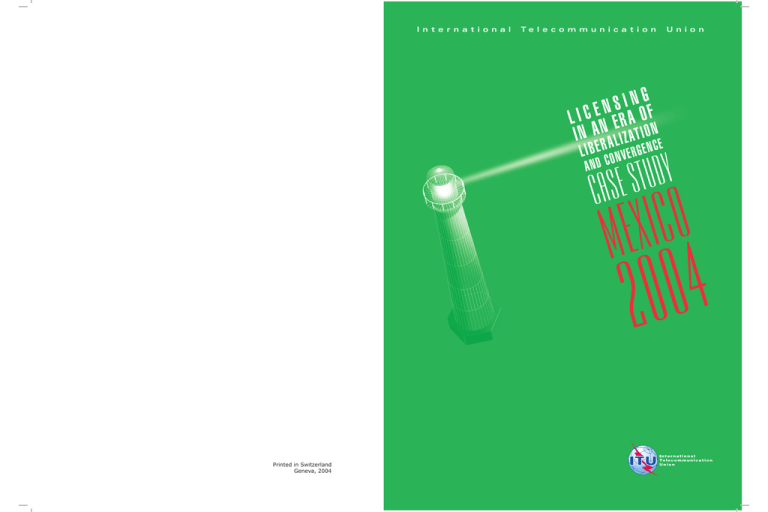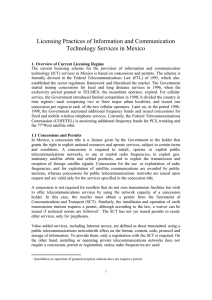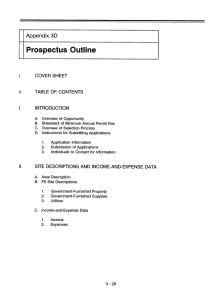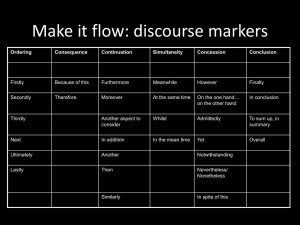2004 MEXICO CASE STUDY S I N G
advertisement

I n t e r n a t i o n a l Te l e c o m m u n i c a t i o n U n i o n G N I S N E C I L N ERA OF I N A A L I Z A T I O NE L I B E R ONVERGENC Y D U T S E S CA AND C O C I EM X 4 0 20 Printed in Switzerland Geneva, 2004 I n t e r n a t i o n a l T e l e c o m m u n i c a t i o n U n i o n Licensing in an era of liberalization and convergence Case study: Mexico 2004 Licensing practices of information and communication technology services in Mexico by Carlos Gómez This case study was conducted by Carlos Gómez, ITU Global Regulators’ Exchange (G-REX) Advisor. This study is intended to be useful not only to the regulatory authorities and the corresponding arms of government but also to everyone concerned with the telecommunication market. The author wishes to express his sincere appreciation to Clara Luz Álvarez González de Castilla, Commissioner, Comisión Federal de Telecomunicaciones (COFETEL), Mexico, for her invaluable assistance in the preparation of this report. The views expressed in this paper are those of the author and do not necessarily reflect the views of ITU, its members or the Mexican Government. This is one of a series of case studies on licensing in an era of liberalization and convergence undertaken by ITU. Further information can be found on the website at <http://www.itu.int/ITU-D/treg> © ITU 2004 All rights reserved. No part of this publication may be reproduced, by any means whatsoever, without the prior written permission of ITU. Licensing in an era of liberalization and convergence – Case study: Mexico TABLE OF CONTENTS Page 1 Overview of Current Licensing Regime ........................................................................................ 1.1 Concessions and Permits ..................................................................................................... 1.2 Duration ............................................................................................................................... 1.3 Fees and Guarantees ............................................................................................................ 1.4 Application Process ............................................................................................................. 5 5 6 6 6 2 Licensing Reforms to Address Convergence ................................................................................. 2.1 Proposed Reforms................................................................................................................ 2.2 Recent Regulations .............................................................................................................. 2.3 Technology Neutrality ......................................................................................................... 6 7 7 8 3 Licensing in an era of liberalization and convergence – Case study: Mexico 1 Overview of Current Licensing Regime The current licensing scheme for the provision of information and communication technology (ICT) services in Mexico is based on concessions and permits. The scheme is formally devised in the Federal Telecommunications Law (FTL) of 1995, which also established the sector regulatory framework and liberalized the market. The Government started issuing concessions for local and long distance services in 1996, when the exclusivity period granted to TELMEX, the incumbent operator, expired. For cellular service, the Government introduced limited competition in 1990; it divided the country into nine regions – each comprising two or three major urban localities – and issued one concession per region to each of the two cellular operators. Later on, in the period 1996-1998, the Government auctioned additional frequency bands and issued concessions for fixed and mobile wireless telephone services. Currently, the Federal Telecommunications Commission (COFETEL) is auctioning additional frequency bands for PCS, trunking and the 77° West satellite orbit. 1.1 Concessions and Permits In Mexico, a concession title is a licence given by the Government to the holder that grants the right to exploit national resources and operate services, subject to certain terms and conditions. A concession is required to install, operate or exploit public telecommunication networks, to use or exploit radio frequencies, to exploit geo-stationary satellite orbits and orbital positions, and to exploit the transmission and reception of foreign satellite signals. Concessions for the use or exploitation of radio frequencies, and for exploitation of satellite communications are awarded by public auctions, whereas concessions for public telecommunication networks are issued upon request and are valid only for the services specified in the concession title. A concession is not required for resellers that do not own transmission facilities but wish to offer telecommunication services by using the network capacity of a concession holder. In this case, the reseller must obtain a permit from the Secretariat of Communications and Transport (SCT). Similarly, the installation and operation of earth transmission stations requires a permit although, according to the law, a waiver can be issued if technical norms are followed1. The SCT has not yet issued permits to resale other services, only for payphones. Value-added services, including Internet access, are defined as those transmitted using a public telecommunication network with effect on the format, content, code, protocol and storage of information. To provide them, only a registration with the SCT is required. On the other hand, installing or operating private telecommunication networks does not require a concession, permit or registration, unless radio frequencies are used. The SCT has authority over all concessions and permits and reviews the application process. However, it is COFETEL, the regulatory authority, who receives the applications. COFETEL is not embodied in the FTL and was created by presidential decree in 1996. In 2002, the National Congress proposed a new FTL that would give COFETEL, inter alia, complete control over permits and registrations. There are no limits to the number of concessions or permits. However, only Mexican nationals can obtain them and foreign ownership is restricted to 49 per cent, except in the case of cellular mobile telephone service, where full ownership is permitted. _______________ 1 Installation or operation of ground reception stations does not require a permit. 5 Licensing in an era of liberalization and convergence – Case study: Mexico 1.2 Duration Concession titles specify the services that the concession holder is authorized to provide to the public, its term, rights and obligations. Concessions for public telecommunication networks may be issued for a term of up to 30 years and concessions for the use of radio frequencies for a term of up to 20 years. The law does not determine the duration of permits. In the past, the SCT has issued permits for the installation and exploitation of payphones for a term of 20 years, but since 2001, the term has been four years. Upon expiration, all concession and permit holders must reapply for a renewal. 1.3 Fees and Guarantees There are no fees charged on concessions for wireline public telecommunication networks. The applicant is only required to submit a guarantee to ensure compliance with the concession obligations. Guarantees have to be submitted at the time the concession is issued and must be updated annually according to the National Consumer Price Index (INPC). The amount varies depending on the number of local service areas where the concession holder may provide the authorized services, and of the service itself. In 2004, the guarantee for a national concession for wireline, wireless or long distance telephone service was 14 million MXN (USD 1.2 million); the guarantee for an interstate concession for cable television was 4.9 million MXN (USD 430,000). 1.4 Application Process The application process for a concession or a permit is identical. The law requires the SCT to resolve applications for permits in 90 days, for public telecommunications in 120 days, and for radio frequencies in 180 days. However, an incomplete application could delay the process for up to a year. Applicants for a concession need to submit complete documentation that includes: technical specifications, such as description of the equipment and technical standards; commitments in terms of local service areas that will be served; investment to be made; quality standards; and a comprehensive business plan that contains financing and marketing programmes, revenue forecasts and details of employment and training programmes. 2 Licensing Reforms to Address Convergence The regulatory framework in Mexico has not yet been fully adapted to accommodate technological convergence. The concession scheme remains segmented and treats separately services such as broadcasting2, data and telephony. Moreover, operators have not yet been authorized to provide a full range of ICT services. The Government has explicitly recognized the need to adapt the regulatory framework to make it compatible with the convergence of telecommunications, broadcasting and informatics. In its Communications Sector Program for 2001-2006 (CSP), the SCT plans to update the FTL to make it compatible with the new regulatory and technological environment. Among other actions, it intends to review the concession procedures to simplify them and increase its transparency, and to start issuing permits to resellers of voice and data services. _______________ 2 The Broadcasting Act (Ley Federal de Radio y Televisión) was enacted in 1960. 6 Licensing in an era of liberalization and convergence – Case study: Mexico 2.1 Proposed Reforms In August 2002, Congress produced a draft FTL that had among its main objectives to facilitate ICT convergence. The following are some of the measures proposed in the draft: • Adopting the principle of technology neutrality • Requiring interconnection for all public telecommunication networks, including cable, in a non-discriminatory and transparent manner • Adopting simplified procedures for obtaining new concessions for public telecommunication networks and for adding or substituting services originally authorized to concession holders • Granting COFETEL the right to issue permits and manage registrations for value-added services • Granting operators an automatic authorization should COFETEL not issue a permit within a defined time period • Empowering COFETEL and eliminating the functional ambiguities with SCT. The draft legislation also proposed the introduction of market dominance analysis and related regulations, maintenance of the 49 per cent limit on foreign investment, and issuance of regulations by COFETEL on access to essential network elements on an unbundled basis. The draft legislation was met with opposition from various interest groups and legislators, and has not been passed by Congress. Negotiations for a new regulatory framework have not moved forward. 2.2 Recent Regulations The SCT and COFETEL have adopted several agreements and regulations to address the phenomenon of technological convergence. In the last quarter of 2003, the SCT amended the concession titles of cable and MMDS3 network carriers, allowing them to provide Internet access services (bidirectional data transmission). The main cable operators were already providing Internet services through a temporary permit. The 2003 amendment, however, did not include satellite television network operators. The SCT recently published a draft amendment for cable service concession titles that will permit them to transport telephone calls over their networks. The SCT also plans to amend the cable service concession titles that will permit them to provide voice services directly to consumers. It has issued temporary permits to some companies to conduct trials for the service. TELMEX has likewise expressed its interest in providing television services over its telephone network. In June 2004, COFETEL issued a new regulation for international long distance service and other cross-border telecommunication services. The main feature in regard to convergence is that it explicitly promotes technology neutrality and opens the way for the use of Voice over Internet Protocol (VoIP) in international communications. VoIP is currently being analysed by COFETEL. The June 2004 regulation also simplifies the procedures for obtaining international long distance concessions, eliminates the proportional return and settlement rate scheme, allows each concession holder to negotiate its own tariffs with foreign counterparts, and authorizes operators to install their own interconnection ports. In July 2004, the SCT adopted standard A/53 from the Advanced Television Systems Committee (ATSC) for the transmission of digital television. At the same time, it established the transition policy and timeline for broadcasters to move from analog towards a high-definition digital network. The policy contemplates the utilization of digital television to offer telecommunication services such as Internet access. _______________ 3 Multi-channel Multipoint Distribution Service (MMDS), also known as wireless cable, is a broadcasting and communications service that operates in the ultra high frequency (UHF) segment of the radio spectrum. 7 Licensing in an era of liberalization and convergence – Case study: Mexico 2.3 Technology Neutrality Technology neutrality was considered in the latest draft of the proposed Telecommunication Act (TA) and in recent regulations. The new rules for international long distance issued by COFETEL state the need to have a regulatory framework that is technology neutral in order to facilitate the convergence of networks and promote the use of new technologies. In its CSP, the SCT did not include an explicit policy to promote technology neutrality but did mention the need to encourage technological innovation. It plans to establish concession obligations in terms of technological modernization to ensure that the ICT infrastructure is based on advanced technologies. _________________ 8






